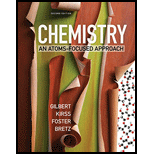
To find:
The tooth enamel is actually a composite material containing both hydroxyapatite and a calcium phosphate,
a) Is this calcium mineral more or less soluble than hydroxyapatite (
b) Calculate the solubility in moles per liter of hydroxyapatite,
c) Explain why the production of weak acids by bacteria on teeth and gums increases the solubility of hydroxyapatite?
Answer to Problem 22.63QA
Solution:
a) Calcium mineral is more soluble because it has higher
b) The solubility of hydroxyapatite,
c) Weak acid produced on teeth and gums reacts with
Explanation of Solution
1) Concept:
The
where
To determine which compound is more or less soluble, we need to compare the
Higher the
2) Formula:
3) Given:
i) Calcium mineral,
ii) Hydroxyapatite,
4) Calculation:
a) Is calcium mineral more or less soluble than hydroxyapatite?
We are given the
Calcium mineral,
Hydroxyapatite,
The compound with higher
b) The solubility in moles per liter of hydroxyapatite,
The dissociation equation for hydroxyapatite,
Therefore, the
According to the stoichiometry of the reaction,
Inserting these variables in the
Plug in the value of
Therefore, the solubility of hydroxyapatite,
c) When the weak acid is produced by bacteria on teeth and gums, the acid (
Therefore, the equilibrium shifts to the right in the dissociation of
Conclusion:
We compared the
Want to see more full solutions like this?
Chapter 22 Solutions
Chemistry: An Atoms-Focused Approach (Second Edition)
- Can I please get help with this?arrow_forwardUse the Henderson-Hasselbalch equation to calculate pH of a buffer containing 0.050M benzoic acidand 0.150M sodium benzoate. The Ka of benzoic acid is 6.5 x 10-5arrow_forwardA. Draw the structure of each of the following alcohols. Then draw and name the product you would expect to produce by the oxidation of each. a. 4-Methyl-2-heptanol b. 3,4-Dimethyl-1-pentanol c. 4-Ethyl-2-heptanol d. 5,7-Dichloro-3-heptanolarrow_forward
- What is the pH of a 1.0 L buffer made with 0.300 mol of HF (Ka = 6.8 × 10⁻⁴) and 0.200 mol of NaF to which 0.160 mol of NaOH were added?arrow_forwardCan I please get help with this.arrow_forwardDetermine if the following salt is neutral, acidic or basic. If acidic or basic, write the appropriate equilibrium equation for the acid or base that exists when the salt is dissolved in aqueous solution. If neutral, simply write only NR. Be sure to include the proper phases for all species within the reaction. N₂H₅ClO₄arrow_forward
 ChemistryChemistryISBN:9781305957404Author:Steven S. Zumdahl, Susan A. Zumdahl, Donald J. DeCostePublisher:Cengage Learning
ChemistryChemistryISBN:9781305957404Author:Steven S. Zumdahl, Susan A. Zumdahl, Donald J. DeCostePublisher:Cengage Learning ChemistryChemistryISBN:9781259911156Author:Raymond Chang Dr., Jason Overby ProfessorPublisher:McGraw-Hill Education
ChemistryChemistryISBN:9781259911156Author:Raymond Chang Dr., Jason Overby ProfessorPublisher:McGraw-Hill Education Principles of Instrumental AnalysisChemistryISBN:9781305577213Author:Douglas A. Skoog, F. James Holler, Stanley R. CrouchPublisher:Cengage Learning
Principles of Instrumental AnalysisChemistryISBN:9781305577213Author:Douglas A. Skoog, F. James Holler, Stanley R. CrouchPublisher:Cengage Learning Organic ChemistryChemistryISBN:9780078021558Author:Janice Gorzynski Smith Dr.Publisher:McGraw-Hill Education
Organic ChemistryChemistryISBN:9780078021558Author:Janice Gorzynski Smith Dr.Publisher:McGraw-Hill Education Chemistry: Principles and ReactionsChemistryISBN:9781305079373Author:William L. Masterton, Cecile N. HurleyPublisher:Cengage Learning
Chemistry: Principles and ReactionsChemistryISBN:9781305079373Author:William L. Masterton, Cecile N. HurleyPublisher:Cengage Learning Elementary Principles of Chemical Processes, Bind...ChemistryISBN:9781118431221Author:Richard M. Felder, Ronald W. Rousseau, Lisa G. BullardPublisher:WILEY
Elementary Principles of Chemical Processes, Bind...ChemistryISBN:9781118431221Author:Richard M. Felder, Ronald W. Rousseau, Lisa G. BullardPublisher:WILEY





